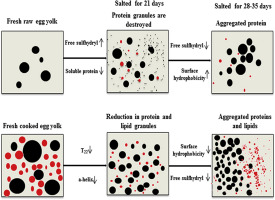当前位置:
X-MOL 学术
›
Food Hydrocoll.
›
论文详情
Our official English website, www.x-mol.net, welcomes your
feedback! (Note: you will need to create a separate account there.)
Changes in aggregation behavior of raw and cooked salted egg yolks during pickling
Food Hydrocolloids ( IF 11.0 ) Pub Date : 2018-07-01 , DOI: 10.1016/j.foodhyd.2018.01.026 Lilan Xu , Yan Zhao , Mingsheng Xu , Yao Yao , Xuliang Nie , Huaying Du , Yonggang Tu
Food Hydrocolloids ( IF 11.0 ) Pub Date : 2018-07-01 , DOI: 10.1016/j.foodhyd.2018.01.026 Lilan Xu , Yan Zhao , Mingsheng Xu , Yao Yao , Xuliang Nie , Huaying Du , Yonggang Tu

|
Abstract In this study, we aimed to investigate the changes in gelation behavior of raw (without heating) and cooked (with heating) salted egg yolks during pickling. Results indicated that the decreasing trend in the main peak T22 of raw and cooked salted egg yolks. Cooked salted egg yolks after 28 days of pickling had a higher release of free lipids as visualized using a confocal laser scanning microscope (CLSM). Transmission electron microscope (TEM) micrographs showed that protein granules were distributed together with lipid spheres in raw and cooked salted egg yolks, and the liberated constituents (lipids and proteins) reorganize and aggregate in cooked salted egg yolks after 28 days of pickling. As the pickling proceeded, the soluble protein content and free sulfhydryl content of raw salted egg yolks, the free sulfhydryl content and surface hydrophobicity of cooked salted egg yolks showed an overall increasing trend, followed by significant decrease. The surface hydrophobicity of raw salted egg yolks exhibited an increasing trend. Differential scanning calorimetry (DSC) results demonstrated that salting can stabilize the protein molecules by an increase in denaturation temperatures. Fourier transform infrared spectroscopy (FTIR) revealed that the secondary structures of egg yolk proteins underwent changes, but no difference in protein patterns of either raw or cooked salted egg yolks was observed by SDS–PAGE during pickling. These results suggested that the characteristic gel of salted egg yolks is formed, as the result of multiple interactions between protein molecules and between protein and lipid molecules.
中文翻译:

腌制过程中生熟咸蛋黄聚集行为的变化
摘要 在本研究中,我们旨在研究腌制过程中生(不加热)和熟(加热)咸蛋黄凝胶行为的变化。结果表明,生、熟咸蛋黄主峰T22呈下降趋势。使用共聚焦激光扫描显微镜 (CLSM) 观察,腌制 28 天后煮熟的咸蛋黄释放出更多的游离脂质。透射电子显微镜 (TEM) 显微照片显示,在腌制 28 天后,蛋白质颗粒与脂质球一起分布在生蛋黄和熟咸蛋黄中,释放的成分(脂质和蛋白质)在熟咸蛋黄中重组和聚集。随着腌制的进行,生咸蛋黄的可溶性蛋白质含量和游离巯基含量,熟咸蛋黄的游离巯基含量和表面疏水性总体呈上升趋势,随后显着下降。生咸蛋黄的表面疏水性呈增加趋势。差示扫描量热法 (DSC) 结果表明,盐化可以通过增加变性温度来稳定蛋白质分子。傅里叶变换红外光谱 (FTIR) 显示蛋黄蛋白质的二级结构发生了变化,但在腌制过程中通过 SDS-PAGE 观察到生或熟咸蛋黄的蛋白质模式没有差异。这些结果表明,由于蛋白质分子之间以及蛋白质与脂质分子之间的多重相互作用,形成了咸蛋黄的特征凝胶。
更新日期:2018-07-01
中文翻译:

腌制过程中生熟咸蛋黄聚集行为的变化
摘要 在本研究中,我们旨在研究腌制过程中生(不加热)和熟(加热)咸蛋黄凝胶行为的变化。结果表明,生、熟咸蛋黄主峰T22呈下降趋势。使用共聚焦激光扫描显微镜 (CLSM) 观察,腌制 28 天后煮熟的咸蛋黄释放出更多的游离脂质。透射电子显微镜 (TEM) 显微照片显示,在腌制 28 天后,蛋白质颗粒与脂质球一起分布在生蛋黄和熟咸蛋黄中,释放的成分(脂质和蛋白质)在熟咸蛋黄中重组和聚集。随着腌制的进行,生咸蛋黄的可溶性蛋白质含量和游离巯基含量,熟咸蛋黄的游离巯基含量和表面疏水性总体呈上升趋势,随后显着下降。生咸蛋黄的表面疏水性呈增加趋势。差示扫描量热法 (DSC) 结果表明,盐化可以通过增加变性温度来稳定蛋白质分子。傅里叶变换红外光谱 (FTIR) 显示蛋黄蛋白质的二级结构发生了变化,但在腌制过程中通过 SDS-PAGE 观察到生或熟咸蛋黄的蛋白质模式没有差异。这些结果表明,由于蛋白质分子之间以及蛋白质与脂质分子之间的多重相互作用,形成了咸蛋黄的特征凝胶。











































 京公网安备 11010802027423号
京公网安备 11010802027423号